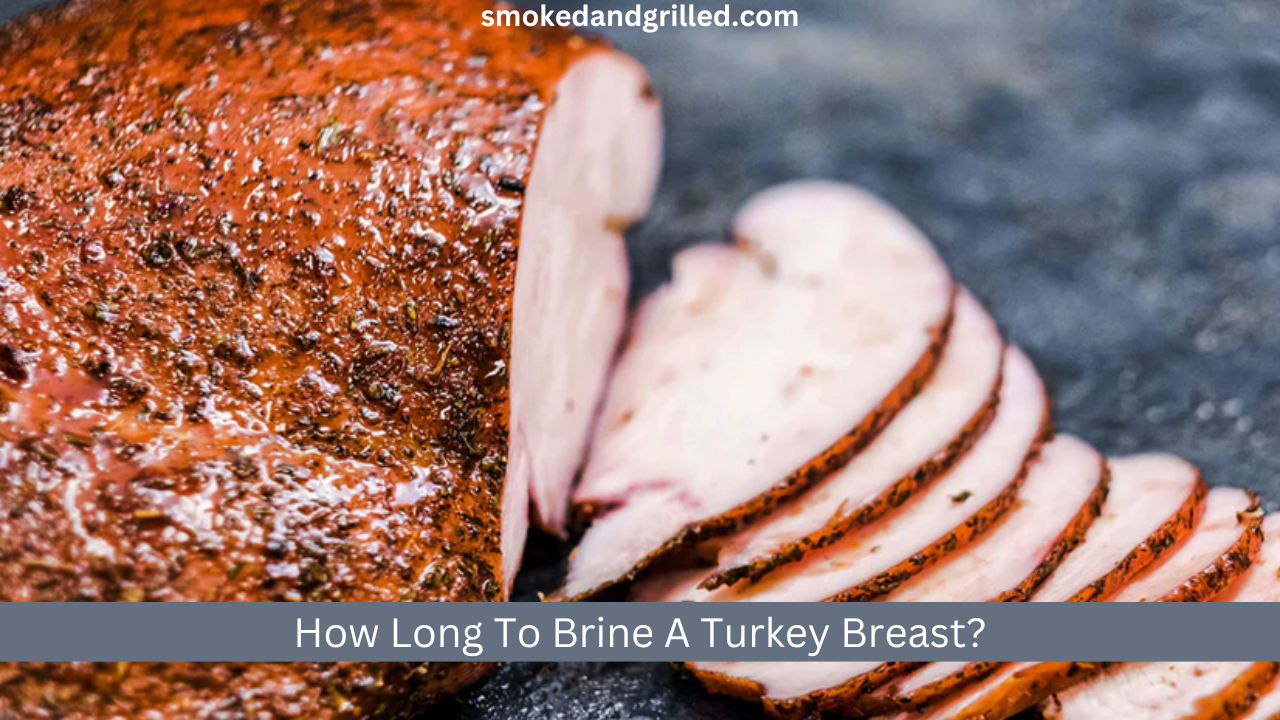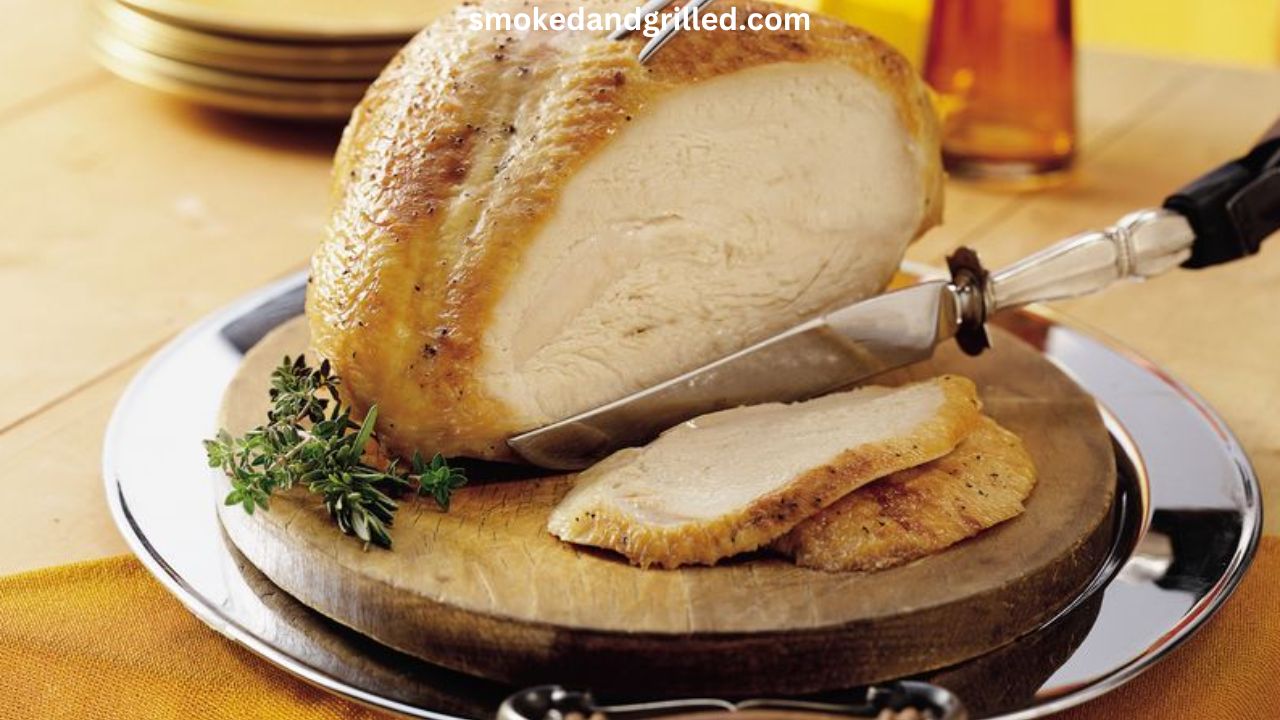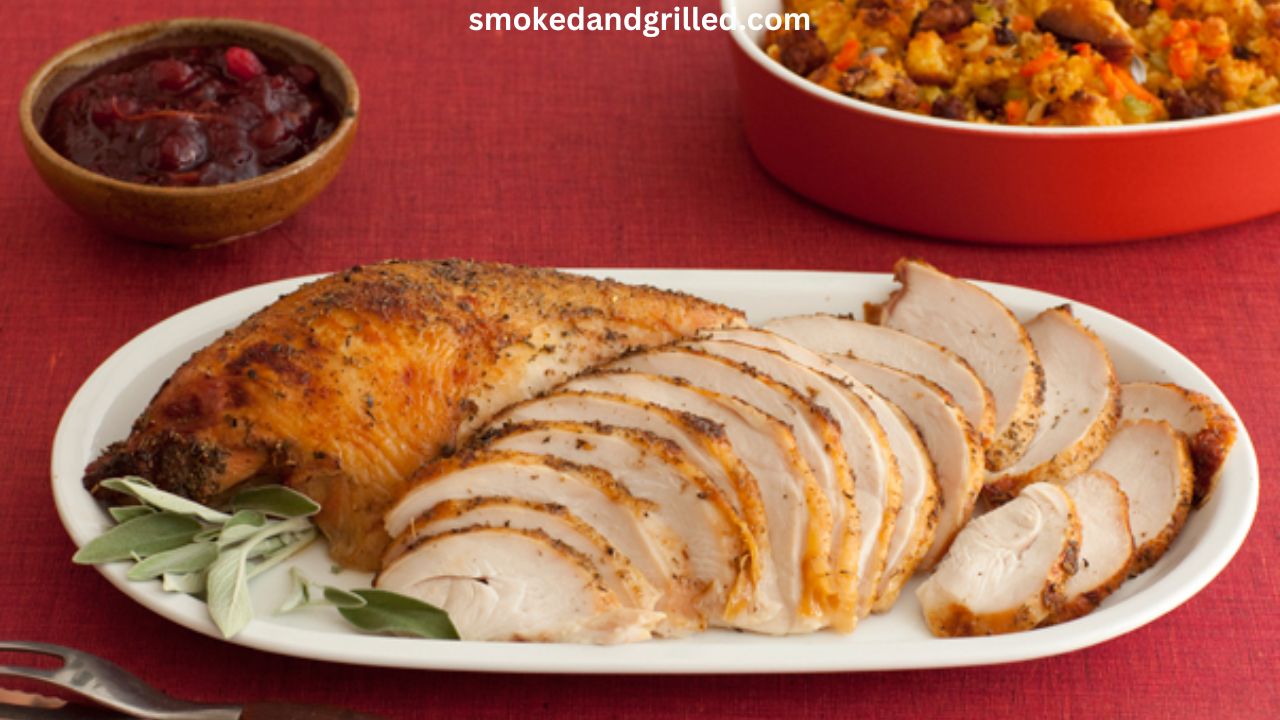A turkey breast that has been properly brined can achieve culinary perfection, where luscious flavors and soft bits are king.
The question on every chef’s mind as they start preparing the feast’s main attraction is this: how long should you brine a turkey breast for maximum flavor?
Get ready for an in-depth exploration of the brining process, during which we’ll reveal the steps required to create a masterpiece that will have your visitors begging for more.
So, get your cooking chops in order, tie on an apron, and join me on a quest to determine how long a turkey breast should be brined.
Related Posts:
- How Long To Brine A Turkey Crown? [Complete Guide]
- How Long to Smoke a 20lb Turkey at 300 degrees? Useful Tips and Tricks!
How Long To Brine A Turkey Breast?
The breast meat of a turkey can be brined for up to 24 hours without spoiling.
To prevent the meat from becoming too salty and losing its texture, this time limit should not be exceeded.
The turkey breast needs to be refrigerated the entire time it is brining to prevent any contamination.
While 24 hours of brining is often recommended, it is not always essential. You can reduce the brining time to reduce the brine flavor if that’s what you like.
While brining, make sure the turkey breast is completely submerged in the brine solution.
Maintaining the turkey breast’s quality and safety during the brining process requires adhering to standard food safety practices, as is the case with any food preparation.
When It Comes To Turkey Breast, What Exactly Is Brining, And Why Is It So Crucial?
Meat is brined when it is submerged in a saltwater solution for a period of time before being cooked.
Brined turkey breast completely changes the game. The method produces juicy and tender turkey by letting the bird to soak up the brine’s flavor and moisture.
The brine’s salt denatures the proteins, which keeps the meat wet while it cooks.
Brined turkey breast has a more robust flavor since the brine’s spices and herbs have had more time to permeate the meat. The end result?
Brining your turkey breast before cooking it can elevate your cooking to the next level, whether you plan on roasting, grilling, or smoking it.
How To Brine A Turkey Breast?(Step By Step Guidance)
Step 1: Gather The Ingredients And Equipment
| Ingredients and Equipment | Purpose |
|---|---|
| Kosher salt | Adds flavor and helps to tenderize the meat |
| Water | Forms the base of the brine solution |
| Sugar | Balances the flavors and enhances browning |
| Additional herbs, spices, and aromatics | Adds extra flavor and aromatics (optional) |
| Large container or food-safe plastic bag | Holds the turkey breast and brine solution |
| Refrigerator space | Provides a cool environment for brining |
Step 2: Make Brine Solution
Bring water to a boil in a big saucepan. The size of your turkey breast and the brining container you’ll be using will determine how much water you’ll need.
Add some kosher salt and sugar to the saucepan after the water is hot. Combine the two ingredients and mix until they are completely dissolved.
The salt and sugar levels are flexible, so you may tailor them to your taste and the size of the turkey breast.
Step 3: Let The Brine Chill
Step 4: Cook The Turkey Breast.
Remove any extra fluids or debris from the turkey breast by rinsing it under cold water. Apply paper towels and pat dry.
Step 5: Add The Turkey Breast To The Brining Vessel.
Put the turkey breast in a large, sealable plastic bag or container. The turkey breast needs to be completely immersed in the brine solution, so use a container or bag that can accommodate this.
Step 6: Brine The Turkey Breast
Carefully soak the turkey breast in the brine solution and refrigerate for at least an hour. If you’re going to use a bag, make sure you get all the air out before you seal it.
Step 7: Chill The Brine
Allow it to brine for the specified amount of time, usually between 12 and 24 hours.
Step 8: Turn The Turkey Breast Over (If Desired, At This Point).
Rotating or flipping the turkey breast halfway through the brining process will help distribute the brine more evenly if you’re brining for a long time.
Step 9: Take The Turkey Breast Out Of The Brine
Take the turkey breast out of the brine when the allotted time has passed. If you want to get rid of the salt that’s sitting on top, you can give it a quick rinse in cold water. Apply paper towels and pat dry.
Do You Think I Could Reuse The Brine For Other Turkey Breasts?
The answer is yes, but there is a proper way to reuse the brine for several turkey breasts. The secret is to prevent any raw chicken from getting into the brine.
Strain the brine to eliminate any leftover food and store it in a new container if you intend to use it again.
Keep the brine in the fridge for up to a week before using.
Brine loses some of its flavor and saltiness with each use, so don’t get too comfortable with reusing it.
Nonetheless, it can serve as a tasty foundation for future turkey breasts.
Brine that has been sitting out for a long time or that exhibits signs of deterioration shouldn’t be used again. If you have any worries regarding the freshness of the brine, you should always throw it away.
If you follow these steps, you can prepare wonderful brined turkey breasts for a variety of occasions without wasting any of your brine.
After I’ve Brined The Turkey Breast, Should I Wash It?
It’s up to you if you want to rinse the turkey breast after brining. Meat that has been rinsed can have any excess salt washed from the surface.
It’s possible that part of the brine’s infused flavor will be lost if you rinse it. Rinse the turkey breast under cold water and pat it dry if you’d like a less salty flavor.
Avoid rinsing the turkey breast if you want to retain all of the brine’s taste and cook it as usual.
To get a crispier skin during cooking, dry the turkey breast thoroughly with paper towels after rinsing it.
The final decision as to whether or not to rinse depends on the cook’s individual preference and the desired saltiness of the finished meal. You can achieve a turkey breast that fulfills your culinary vision through trial and error.
Is It Worth It To Brine A Turkey For 2 Hours?
Two hours of brining time is sufficient to enhance the flavor and moisture retention of a turkey breast, but lengthier brining times are recommended for the best results.
The turkey breast is able to thoroughly absorb the brine’s tastes and moisture over the course of a 12- to 24-hour brining period, making for a juicier and more flavorful final product.
The extra time in the brine guarantees that the tastes will permeate every bit of the meat, making for a memorable meal.
A shorter brining duration, say 2 hours, may result in a more subtle improvement in flavor and texture due to the reduced intensity of the brine’s effects.
To get the finest results and to fully appreciate the tenderness and flavor of the turkey breast, it is recommended that a longer brining period be used if at all possible.
Does A Brined Turkey Breast Cook Faster?
You can expect your turkey breast to be ready to eat sooner if you brine it.
The proteins in the meat are more easily broken down by the salt in the brine, making the flesh more soft and simpler to prepare. However, watch the time and temperature carefully to avoid overcooking.
The turkey breast is less likely to become dry when cooking because of the brining process.
The turkey breast will cook more quickly and uniformly thanks to the moisture preserved by brining.
To avoid overcooking the brined turkey breast and achieve the appropriate doneness, proper cooking procedures must be adhered to.
If you want a juicy and flavorful turkey breast, let it sit after cooking so the liquids can redistribute.
A brined turkey breast can be the star of the feast if you pay close attention to the timing and temperature during cooking.
Does The Brining Time Differ If I’m Using A Fresh Or Frozen Turkey Breast?
Whether you’re using a fresh or frozen turkey breast, the brining time will need to be adjusted accordingly. The suggested brining period for fresh turkey breast is between 12 and 24 hours.
If you’re using a frozen turkey breast, though, you’ll need to let it thaw entirely before brining. After defrosting, proceed with the brining process as you would with a fresh turkey breast.
For uniform brine absorption, make sure the turkey breast is completely defrosted before brining.
You can proceed with the brining process as you would with a fresh turkey breast once the turkey breast has thawed completely.
To get the greatest results when brining a frozen turkey breast, you need to be patient and let it thaw completely.
FAQs
How Does Brining Affect The Texture And Flavor Of The Turkey Breast?
Turkey breast benefits from brining because it retains more moisture after being cooked, making it juicier and more tender. It adds additional flavor to the meat and makes it taste better.
Because the proteins in the turkey breast are broken down during the brining process, the meat becomes supple and succulent, and the brine’s tastes permeate the meat, giving it greater depth and complexity.
Are There Any Variations In Brining Time Based On The Weight Of The Turkey Breast?
There isn’t much of a difference in brining time for turkey breasts of different weights.
For optimal flavor and moisture absorption, a 12- to 24-hour brining period is suggested.
While the brining time is fixed, the cooking time for the turkey breast may change depending on its weight.
Can I Brine A Turkey Breast In A Plastic Bag?
Using a plastic bag for brining a turkey breast is a valid option.
Make sure the bag is strong enough to hold its contents without ripping or leaking and is well sealed to avoid contamination.
If you’re going to use a plastic bag for brining, set it inside a larger container or a roasting pan so that any leaks can be contained outside of your fridge.
Is It Necessary To Rinse The Turkey Breast After Brining?
Whether or not you want to rinse the turkey breast after brining is a matter of taste.
It is not required to rinse off the salt, but doing so can aid.
Don’t rinse if you want to keep the brine’s full taste impact.
After brining the turkey breast, rinsing it is optional, but if you do, be sure to pat it dry with paper towels so it will brown and crisp up properly while cooking.
What If I Don’t Have Enough Refrigerator Space For Brining The Turkey Breast?
If you don’t have a dedicated refrigerator for brining, a large cooler with ice packs can do the trick.
Keep the cooler in a cool place and soak the turkey breast completely in the brine.
The turkey breast can also be brined and stored in a cold location, like a basement or garage.
Use a clean, food-grade pail or container. For the sake of food safety, check the temperature frequently to make sure it stays below 40 degrees Fahrenheit (around 4 degrees Celsius).
How Do I Know If The Turkey Breast Is Fully Brined?
Whether or not the turkey breast has been properly brined can be determined with a taste test.
Take a nibble of the meat and see what you think. The meat has likely been adequately brined if the flavor has been well infused and the texture is moist.
If the brining time needs to be adjusted, write the new time down.
The breast meat of the turkey should be plump and firm to the touch, demonstrating that it has absorbed the brine properly.
Conclusion:
When it comes to taste and tenderness, brining a turkey breast is an approach that consistently delivers the goods.
Meat should be brined for at least 12 hours so that the aromas can permeate and the texture can improve.
Even though the brining time won’t change, you’ll need to allow extra time for thawing frozen turkey breasts before brining.
Kosher salt, water, and sugar are the foundation of a turkey breast brine, but other herbs and spices can be added for variety.
After brining, some people like to rinse the turkey breast to remove excess salt, although this step is optional.
If you don’t have enough room in your fridge, you can always use a cooler or another cool place.
You can tell if the turkey breast has been properly brined by tasting it and feeling it for a combination of plumpness and a slight hardness.
A turkey breast that has been brined is more tasty and tender, making a meal fit for a special occasion even more enjoyable for everyone.
Also Read:



